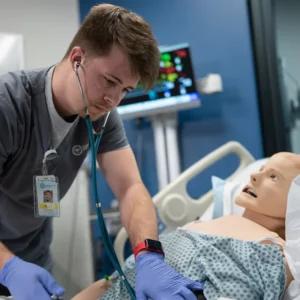
The Electrical Technology (ET) program at Carrington College Phoenix offers a certificate program in as few as 10 months, and an associate degree in as few as 15 months—making it possible for graduates to quickly begin working in the field.
According to the Bureau of Labor Statistics, “The median annual wage for electricians was $56,180 (May 2019)…Employment electricians is projected to grow 10 percent from 2018 to 2028, faster than the average for all occupations. Increases in construction spending and demand for alternative energy sources will drive demand for electricians.”
Electrical technology is a vast industry, with opportunities to work in residential, commercial and industrial settings, each with its own set of skills, methods, and materials. The ET program covers these skills and more, offering students hands-on training labs for three trades programs— Electrical Technology (ET); Heating, Ventilation, Air Conditioning and Refrigeration (HVAC-R); and Industrial Maintenance Technology (IMT). Kim Schofield is a Lead Electrical Technology instructor.
“It’s a lot about students’ interests,” explains Kim. “Once they get exposure to various facets of the field, it can help them determine where they want to be and what they want to do. Our goal is to expose them to a wide array of electrical skills and tailor their interests to the opportunities.”
Throughout the past thirty-plus years, Kim has had exposure to many different areas of the trades industry. He began as a production line mechanic, where he developed an appreciation for machine controls and the electronics trades program. He worked as an electrical and mechanical technician, performing preventative maintenance, machinery repair, machine building, and installations of a wide variety of manufacturing equipment. He was also CEO of his own electrical contracting business for nine years.
“I have a love and forte for machine controls,” he explains. “There is nothing like building a machine and its controls from the ground up.”
Machine controls are the brains of the machine—an assembly machine relies on programmed cycles that sort, orient, and press component pieces together; an electrical technician automates such an assembly machine, increasing efficiency and preventing human repetitive motion injuries in tasks that would otherwise be manual.
“Whether you’re making computer chips or chocolate chip cookies, you have steel chunks that won’t do anything unless you have controls that puts the brains to the steel,” Kim explains.
Upon completion of the Electrical Technology program, graduates will be able to:
• Discuss theories of electrical circuitry and relate these concepts to practical applications.
• Apply proper procedures for the installation, operation, maintenance and repair of residential, commercial, and light industrial wiring, electrical equipment and systems.
• Demonstrate proper usage of the basic tools of the trade.
• Demonstrate the basic use and application of the National Electrical Code.
• Create effective reports and documents, electronically and in writing.
• Apply advanced electrical concepts and critical thinking skills to interpret and create blueprint drawings for residential, commercial and light industrial facilities.
• Adhere to national, state, and local safety practices used by technicians working in the electrical industry. The following are examples of what Electricians do, according to the U.S. Bureau of Labor Statistics:
- Read blueprints or technical diagrams
- Install and maintain wiring, control, and lighting systems
- Inspect electrical components, such as transformers and circuit breakers
- Identify electrical problems using a variety of testing devices
- Repair or replace wiring, equipment, or fixtures using handtools and power tools
- Follow state and local building regulations based on the National Electrical Code
- Direct and train workers to install, maintain, or repair electrical wiring or equipment
“The program curriculum is written to give them hands on experience in our awesome labs,” Kim explains. “We’re looking forward to showing local employers, through networking and open house opportunities, just how our students can provide value to their organizations.”
Kim enjoys sharing his experience and knowledge with his students.
“When you have done it as long as I have, you’ve done things right and you’ve done things wrong,” he says. “If I can help people avoid pitfalls while giving them knowledge that will benefit them, I’m happy to share both sides of it, happy to share what I learned from my mistakes.”
With people moving to Phoenix and opening businesses such as light manufacturing, Kim is excited for the stability and growth of the trades industry, which would be great for our city, its businesses, and our ET graduates alike.



